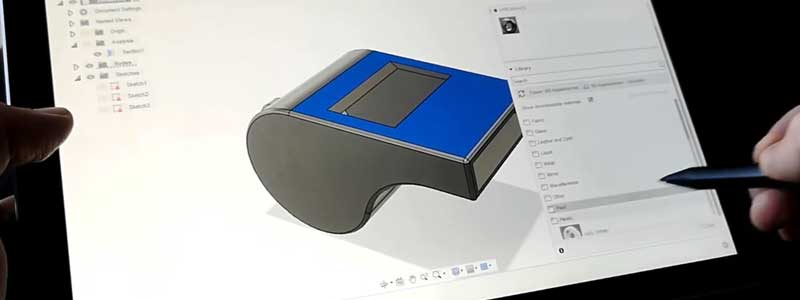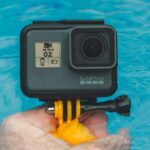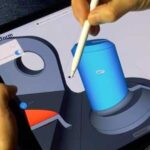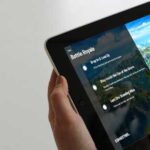For product designers and engineers, especially working with 3D model design and 3D printing, Autodesk Fusion 360 is just a go-to program. Its simple but powerful features, capability to seamlessly execute parametric modeling, offline and online team integration, and intuitive learning experience made it a love-favorite among power users.
Our Overall #1 Top Recommendation!
Affiliate links / Images from Amazon Product Advertising API
Although the full version only works on desktop computers and laptops, Autodesk Fusion 360 has enabled sharing and collaboration through mobile devices as part of its cloud-based desktop products. Users can comment, mark up, and view designs made by their team anytime, anywhere. Doing client presentations will also be easier with less paper on the go.
In picking up your choice for a tablet, it’s essential to consider your workflow and a few other things that would make your experience smoother. There are many tablets available in the market nowadays, and while most of them have very similar features and specifications, the experience of using them still differs.
Here, we try to see first what makes the best tablet for Fusion 360.
Best Tablets for Autodesk Fusion 360 – Buyer’s Guide
Screen Clarity and Resolution
Starting with its display, even with just looking at pictures, a crispy resolution highly enhances our viewing experience, especially for product models that need to be checked and scrutinized. A higher pixel count also means zooming in and seeing the details more closely.
Smoothness and power
Better power for the device means that there will be more minor lags while you swipe, zoom, and annotate. Depending on how many details you work with, more layers in your file will need more processing power and memory to run without hiccups.
More powerful tablets would help you go through seamless design sessions without having to wait for the tablet to buffer.
Screen Size
From full-size motor engine designs, bolt parts to advance manufacturing tools, the bigger the screen would mean a more extensive playground for you.
While this aspect still highly depends on your workflow, especially on how you move from one place to another, it’s still very satisfying to have more blank space for your work to get immersed in that productive zone.
Battery life
Again, depending on your schedule, you have to consider how much battery you need for a whole day. Batteries have gotten better compared before with higher capacity. Regarding the processing power that tablets can perform now and the screen real estate that the battery has to light up, power consumption can still be a problem for some devices.
Picking an efficient device not only ensures that you’re in the zone for the longest possible time when you’re out and about but also makes sure that you have juice whenever you need it.
Other inputs and auxiliary
While tablets have touch as the primary input mode, it’s also worth checking out other media like mouse or stylus pens. These inputs can offer higher precision than our fingers for some tasks.
Mouse support is commonly available through Bluetooth connectivity, and tablets nowadays usually sport their pens or pencils to give users that satisfying feeling of writing on paper. These choices come down to picking which device gives us the best implementation.
As for ports, a tablet doesn’t usually have plenty because of its design geared toward mobility, but it’s essential to have this flexibility and support other than putting everything on the cloud. For instance, HDMI output connecting to TV and larger monitors would be helpful if you’re presenting to a group.
Getting pictures from SD Cards out of the camera in full resolution would be a dream, and quickly copying and transferring files from USB type-A memory sticks would be handy.
We know, we know, USB-A, today? The adaptation of USB type C inputs has made the industry lag behind, and so far, we’re just slowly seeing its application as charging cables being more efficient. Still, for simple file transfer, USB-A remains the go-to option.
Let’s start. Here are the five tablets that we think would be best if you use the mobile version of Autodesk Fusion 360.
BEST FUSION 360 TABLETS AT A GLANCE
Apple iPad Pro (5th Gen)
- Wi -Fi
- 12.9-inch. Liquid Retina 2732×2048
- Apple M1 chip 8/16, GB 128 GB – 2TB
- Up to 10 hours
- iPadOS 15
SAMSUNG Galaxy Tab S7+
- Wi -Fi / Wi -Fi + Cellular
- 12.4-inch Super AMOLED 2800 x 1752
- Qualcomm SDM865 Octa Core, 6/8 GB, 128/256/512 GB
- Up to 14 hours
- Android 10
Lenovo Yoga Tab 13
- Wi -Fi
- 13-inch LTPS 100% sRGB Dolby Vision 2160 x 1350
- Qualcomm SD870 , 8 GB, 128 GB
- Up to 12 hours
- Android 11
Apple iPad Air (4th Gen)
- Wi -Fi / Wi -Fi + Cellular
- 10.9-inch IPS 2360×1640
- A14 Bionic chip, 4 GB, 64/256 GB
- Up to 10 hours
- iPadOS 15
Samsung Galaxy Tab A7
- Wi -Fi
- 10.4-inch Super TFT, 2000 x 1200
- Exynos 9611, 3 GB, 32 GB
- 7,040mAh
- Android 10
Our Overall #1 Top Recommendation!
Affiliate links / Images from Amazon Product Advertising API
Best Tablets for Autodesk Fusion 360 – Recommendations
The Ultimate iPad for Autodesk Fusion 360
- Type: Wi -Fi / Wi -Fi + Cellular
- Weight: 16.48 Oz
- Display: 12.9-inch Liquid Retina, 2732 x 2048, 600 nits
- Cameras: 12 MP Wide + 10MP Ultrawide, 12 MP Ultra Wide
- Processor: Apple M1 chip
- Memory: 8/16 GB
- Storage: 128 GB – 2TB
- Battery: Up to 10 hours
- OS: iPadOS 15
Released in 2020, the M1 chip launched for Apple’s Mac lineup found its way to the iPad Pro line early last year, making it a formidable candidate for creators and designers.
Design and Features
There are not many redesigns on its looks outside, but the internals got every possible upgrade. The display is now a Liquid Retina display XDR powered by mini Led technology. It has a crispy resolution of 2732 x 2048, with a pixel density of 264 PPI.
Moreover, iPad Pro has a ProMotion technology display that adjusts the refresh screen rate up to 120 Hz based on your usage. For connectivity, this new device is 5G, and the Wi-Fi 6 ready.
There are two cameras at the back with a wide, 12MP f/1.8 aperture, ultra-wide, 10MP, f/2.4 aperture, and 125º field of view. The front camera remains at a 7 MP lens, but Apple included the Centerstage feature that follows you on the frame, which is very handy as the iPad’s camera is in a weird place when placed in landscape mode, which is almost always.
It is also equipped with a LiDar scanner that would help more accurately measure and range objects.
iPad Pro also supports Apple Pencil 2 as an additional input option.
Performance & Storage
Zooming into its M1 chip, there’s an 8-core CPU, 8-core GPU, and 16-core neural engine. It means that you will have less lags and buffering while you move files with many components.
The base model comes with 8GB RAM, and because of an optimized Apple device, it is already enough for most intensive tasks and programs. You can extend that to 16GB RAM if you think you need more, but it’s only available for 1 TB or 2 TB storage options.
Both models also have lower storage models at 128GB, 256GB, and 512GB.
Battery
Apple advertised iPad Pro’s battery life at around 10 hours for the 11-inch model with about ~7538 mAh capacity and the 12.9 model with 10,758 mAh. It decreases an hour to 9 hours for LTE variants of both models.
Conclusion
With a very formidable tablet running on a well-built ecosystem, this tablet is highly recommendable if you’re looking for a good value tablet that has the power to process large data files for your Fusion 360 projects. The iPadOS still has a lot of improvements to go, but the current version is more than good enough for any project through Fusion 360.
✓ PRO
- Excellent screen
- Powerful processor
- LiDAR feature and fantastic camera system
- Software update support for a long time
✗ CONS
- Very Expensive
- No Micro-SD Slot
- Limited functionality of iPadOS
The Best Android Tablet for Autodesk Fusion 360
- Type: Wi -Fi / Wi -Fi + Cellular
- Weight: 20.48 Oz
- Display: 12.4-inch Super AMOLED 2800 x 1752
- Cameras: 13MP Ultrawide + 5MP, 8MP
- Processor: Qualcomm SDM865 Octa Core (3.09+2.4G+1.8GHz)
- Memory: 6/8 GB
- Storage: 128/256/512 GB (Expandable up to 1TB)
- Battery: 10090mAh
- OS: Android 10.0
Samsung’s flagship tablet is undeniably one of the most feature-packed tablets in the market today. Also designed for creators, the tablet has been updated using the latest chip to catch up with the most intensive workflows.
This Android-based tablet would make more sense for a Windows user as it supports that ecosystem.
Design and Features
Today, Samsung managed to create one of the best-looking tablets using a Super AMOLED display with HDR10+ support. Encased in a thin and light frame, the Galaxy Tab S7 is available in three colors- mystic black, mystic bronze, and mystic navy.
Samsung Galaxy Tab S7+ has a very portable weight at 600g and a thickness of just 5.7mm. At 12.4 inches, its resolution is at 2800 x 1752 giving 266 PPI with a 16:10 display ratio and 120 Hz variable rate screen refresh, a feature that also responsively reacts and adjusts its refresh rate based on your content or activity.
Two main cameras are mounted vertically with a slight bump at the back. These are the 5MP F/2.2 ultra-wide camera and the 13MP F/2.0 wide-angle camera. While the front camera is an 8MP, f/2.0 ultra-wide lens. The tablet supports the famous S-pen with ultra-low latency for precision input. Video recording can support 4K up to 30fps.
Its quad speakers feature Dolby Atmos while the sound was tuned by AKG, following their partnership with the brand for earphones that ships with their phones.
For its connectivity, the tablet is also Wi-Fi 6 and LTE 5G ready with Bluetooth 5.0 for your peripherals.
Performance and Storage
Qualcomm Snapdragon 865+ Octa-core is at the heart of its CPU. Compared to the previous model, graphics is 36% faster, the performance of its core CPU is 25% faster, while the neural processor that helps with AI computations has improved a whopping 77% faster.
Together with 8GB of RAM, this tablet will give you the ability to multitask whenever with your Fusion 360 projects.
Storage is fixed at either 128GB, 256GB, or 512GB for the S7+, but you can add up to 1 TB of storage via a micro SD card.
Battery
S7+ has around 10,090 mAh with an advertised battery life of 15 hours, but this is just for watching videos over Wi-Fi and light browsing. Real-world performance may vary approximately 8-10 hours, depending on how extensive the use.
Conclusion
For those that would like to maintain working on the Android platform, the S7+ tablet will give you the best experience in this ecosystem. It is packed with powerful features to run the most extensive files in Fusion 360, plus with its current display, your pictures and designs would pop.
✓ PROS
- Excellent screen with HDR+ support
- Flagship processor
- Dolby Atmos
- Micro SD card slot up to 1TB
- Value price
- S-Pen already included
✗ CONS
- Android still lags behind the iPadOS
- Limited years of software support
Another Superior Choice for Fusion 360
- Type: Wi -Fi
- Weight: 29.28 Oz
- Display: 13-inch, LTPS 100% sRGB Dolby Vision, 2160 x 1350
- Cameras: 8MP
- Processor: Qualcomm SDM870 up to 3.2GHz
- Memory: 8 GB
- Storage: 128 GB
- Battery: Up to 12 hours
- OS: Android 11
Following the success of their laptop ThinkPad line, Lenovo has been a rising name in the tablet market through their Yoga series. It’s geared initially more for entertainment, but its specifications are more than enough to take on larger files for Fusion 360.
Design and Features
The chassis is probably the most interesting in the market today. Aside from the tablet has a long cylindrical base where the USB port and mini-HDMI port reside. It also has a kickstand that swivels down as the main stand or, depending on your location, can be used to hook the tablet hanging upside-down. It is weird but convenient if you’re at a site and need to present then and there, although its brightness can only go as high as 400 nits.
The display is 13 inch LTPS with a 2160 x 1350, 196 PPI, supported by 100% sRGB Dolby Vision. Sadly, its refresh rate is just at 60 Hz, which would be a bit of a step down if you’re using higher refresh monitors.
There’s only one color, Shadow Black with Alcantara lining, which is known for its durability. Just like most tablets nowadays, it supports Lenovo’s Active Pen 2, which has around 4096 pressure points for even more precision so you can better work on your imagery and components.
Lenovo also chose the other way for the camera, as there’s only one 8MP front-facing lens. Yes, there’s no rear camera, which could have been excellent for getting quick snapshots of product details and directly using it as a reference for rendering.
As for connectivity, the Yoga Tab 13 is supported by Wi-Fi 6, Bluetooth 5.0, but no 5G connection. The speakers are Dolby Atmos supported with JBL quad front-firing speakers, impressive for a tablet. The sound is built for entertainment, that’s one thing for sure. We don’t need a good one for Fusion 360, but it will make you enjoy working more with Pink Floyd urging you to in the background.
Performance & Storage
The Tab 13 is powered by a Qualcomm Snapdragon 870 Octa-core supported by 8GB LPDDR5 RAM, non-expandable, I’m afraid. For the storage, the base model starts at 128GB with no support for a micro-SD card which is a letdown considering it’s perfect for entertaining, and speakers would sound great for FLAC files.
Battery
The tablet has about 10,000 mAh and claims around 12 hours of battery life at contained usage. Depending on your workflow again, its usage time may decrease accordingly.
Conclusion
It’s a capable device supported by the Android platform, but there are so many features lacking compared to the competition. Based on our experience in using even the old iPad Pro models, the 120 Hz screen makes a lot of difference even with the simple gestures to move and resize the components we’re working on, Fusion 360.
✓ PROS
- Large display with 100% sRGB Dolby Vision support
- Dolby Atmos
- Value price
- Fantastic performance
✗ CONS
- Screen at only 60 Hz
- No front-facing camera
- Limited years of software support
- No micro-SD slot
Portable and Large iPad for Fusion 360
- Type: Wi -Fi / Wi -Fi + Cellular
- Weight: 16 – 17.6 Oz
- Display: 10.9-inch IPS, 2360×1640
- Cameras: 12 MP, 7 MP
- Processor: A14 Bionic chip
- Memory: 4 GB
- Storage: 64/256 GB
- Battery: Up to 10 hours
- OS: iPadOS 15
Even with fewer features than its big brother, the iPad Pro, the 2020 iPad Air, can handle tasks for most users. As with Apple’s lineup, its quality and performance outperform any other tablet in the market at a more reasonable price than the Pro model.
Design and Performance
There are five colors available that sets it apart from the Pro lineup. There’s the usual silver and space gray, then comes the new rose gold, green, and sky blue. The display is 10.9 IPS Led with 2360 x 1640 resolution; about 264 PPI. It can high up to 500 nits of brightness—no ProMotion display for now.
There’s only a single camera in the back, a 12 MP wide with f/1.8 aperture. It supports 4K recording at 60fps and cinematic video stabilization. There are four grill outputs but only two firing speakers on the left side of the tablet when on portrait mode. For security, the iPad Air uses a Touch ID baked on the power button rather than the Face ID used by the Pro models.
The iPad Air supports Wi-Fi 6 connectivity but no 5G support for its LTE devices.
Lastly, it also charges via USB-C, and no other ports are present, so dongles are necessary.
Performance and Storage
Powered by the A14 Bionic chip, it can handle tasks smoothly, yes, even larger files for Fusion 360. It supports the Apple Pencil 2 and the Apple Magic Keyboard for more precise inputs.
Storage starts at 64GB up to 256 GB. As with Apple, there never was an option for expandable external storage.
Battery
Its battery capacity is at 7606 mAh, which with light usage can last all day, or what Apple advertises. Although again, expect a lower screen on time if you’ll be using more intensive programs.
Conclusion
There’s always a debate on whether to get the Pro or the Air. The key to answering that is to review your workflow. Would you need the 120 Hz that the iPad Pro offers, or are you content with the performance of the current iPad Air at 60 Hz?
Would you need a better screen and display? If you don’t need that much power, this iPad Air would be perfect for your use.
✓ PROS
- Powerful processor
- Magnificent display
- Lightweight design
- Colorful selection
✗ CONS
- Less battery performance
- Software update support for a long time
Best Budget Android Tablet for Autodesk Fusion 360
- Type: Wi -Fi
- Weight: 16.80 Oz
- Display: 10.4-inch TFT, 2000 x 1200
- Cameras: 8MP + 5MP
- Processor: Exynos 9611
- Memory: 3 GB
- Storage: 32/64 GB (Expandable up to 512GB)
- Battery: 7.040mAh, up to 15 hours
- OS: Android 10
Moving down the list, Samsung’s A-line brings in the value for the buck for low-end tablets that can do so much. The little brother of S7+, the A7 is built more for entertainment than for power users, but what it does well as the Lenovo Yoga does makes it very attractive for Fusion 360.
Design and Features
You’d know a Tab A7 from afar because its colors are all shinier than its big brother. It’s very slim at only 7mm thick and weighs about 477 g. The screen size is 10.4 inches, with a generous 2000 x 1200 resolution. The camera is 8 MP at the rear and 5 MP at the front. Video recording is up to
Speakers are supported by Dolby Atmos, and they sound good.
Performance and Storage
There’s no fancy flagship chip, but it’s also Octa-core at 2.0 Hz CPU speed with only 3GB of RAM. It was made for streaming and some, and for fusion 360, it can handle beginner and smaller files.
Storage
The base model starts at 64GB, very little in our time of significant consumption, but it’s expandable to up to 1TB via micro-SD card.
Battery
The Tab A7 is at 7040 mAh. It’s not much compared to the more pro tablets above, but it can stretch to up to 5-6 hours of mid-range usage because of the smaller package and more low-profile processor.
Conclusion
The experience would not be as good as the other flagship tablets, but for newbies that are starting to learn the environment of Fusion 360 and doing minor detailing and marking up, this tablet would be more than enough.
✓ PROS
- Outstanding display
- Supports Dolby Atmos
- Has headphone jack
✗ CONS
- Underpowered
- Limited Base Storage
Top Rated Tablets for Autodesk Fusion 360
- Apple iPad Pro 5th Gen
- SAMSUNG Galaxy Tab S7+
- Lenovo Yoga Tab 13
- Apple iPad Air 4th Gen
- Samsung Galaxy Tab A7
As an Amazon Associate I earn from qualifying purchases. Learn more.







